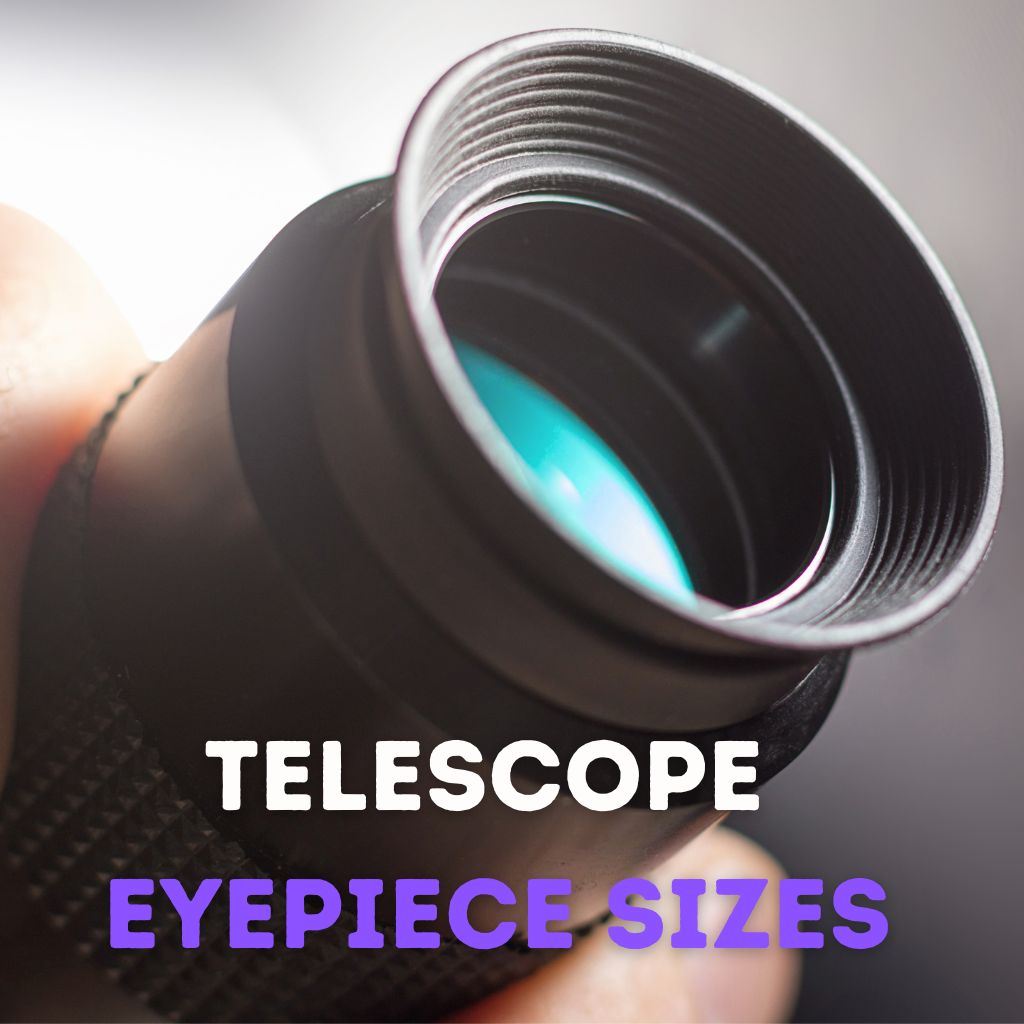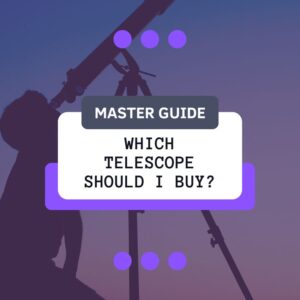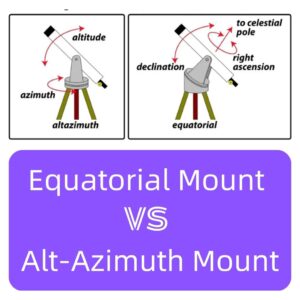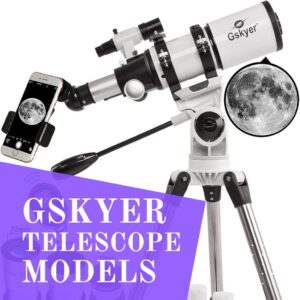This site contains affiliate links to products. I may receive a commission for purchases made through these links.
Eyepieces, also known as oculars, are essential to telescopes and microscopes. They help magnify the image that the main lens or mirror is focused on. The eyepiece is the last element through which light passes before it reaches the eye, thus greatly influencing the viewing experience.
Understanding telescope eyepiece sizes is paramount for any avid stargazer or aspiring astronomer. Knowing the ins and outs of telescope eyepiece sizes is vital.
In this article, we will look at telescope eyepieces and provide you with a complete understanding of their sizes and how they affect your astronomical observations.
Telescope eyepiece sizes explained (quick overview)
The size of an eyepiece, specifically its focal length and barrel diameter, significantly impacts the viewing experience. An eyepiece’s focal length determines the magnification level achieved when used with a particular telescope.
Short focal length eyepieces provide higher magnification, resulting in closer and more detailed views of celestial objects.
In contrast, a longer focal length eyepiece offers a wider field of view, enabling observers to take in larger portions of the night sky.
The barrel diameter of an eyepiece plays a crucial role in determining compatibility with the telescope’s focuser. Common barrel sizes include 1.25 inches and 2 inches.
The larger 2-inch eyepieces allow for a wider field of view and can accommodate wider field eyepiece designs, while the 1.25-inch eyepiece does not allow a wider field of view.
However, not all telescopes are designed to accommodate 2-inch eyepieces, so it’s essential to check the specifications of your telescope’s focuser before purchasing.
The two common sizes of telescope eyepieces: 1.25-inch and 2-inch
The two most common types of telescope eyepiece are 1.25-inch and 2-inch. These standard sizes are crucial in determining your viewing experience and compatibility with telescopes.
Let’s discuss each of them in detail.
1.25-inch eyepieces
The 1.25-inch eyepiece is a commonly used accessory in astronomy, designed to enhance the viewing experience through telescopes. This eyepiece size finds its utility in a variety of astronomical observations.
The 1.25-inch eyepiece proves to be suitable for a range of applications with its moderate focal length and compatibility with different telescope models.
Pros of the 1.25-inch eyepiece
- Generally more affordable compared to larger eyepieces, providing a cost-effective solution for astronomy enthusiasts.
- Versatile focal length range, offering a balance between magnification and a wider field of view.
Cons of the 1.25-inch eyepiece
- Relatively narrower field of view compared to larger eyepieces, which may require multiple observations to capture wide celestial objects.
- Potential for lower eye relief, especially with shorter focal length designs, which may impact viewing comfort for eyeglass wearers.
2-inch eyepieces
The 2-inch eyepiece is characterized by its larger barrel diameter compared to the standard 1.25-inch size. This increased size allows for several advantages when it comes to observing the night sky.
This eyepiece size is particularly beneficial for locating and tracking objects in the night sky, making navigating and exploring the cosmos easier.
Pros of the 2-inch eyepieces
- Enhanced viewing comfort with longer eye relief, accommodating eyeglass wearers more effectively.
- Reduced vignetting and increased brightness due to the larger aperture, resulting in improved image quality.
- Offers a wider range of available focal lengths, allowing for greater flexibility in choosing magnifications.
Cons of the 2-inch eyepieces
- Generally higher cost compared to 1.25-inch eyepieces, making them a more significant investment for astronomy enthusiasts.
- Compatibility limitations with certain telescope models, as not all telescopes are designed to accommodate 2-inch eyepieces.
1.25-inch eyepiece vs 2-inch eyepiece
Let’s compare the 1.25-inch and 2-inch eyepieces, focusing on their differences in size and performance.
The 1.25-inch eyepiece has a smaller barrel diameter compared to the 2-inch eyepiece
This compact size is the standard for most telescopes, allowing for easy insertion into the telescope’s focuser. The smaller diameter makes the 1.25-inch eyepiece lightweight and portable, suitable for various telescope models.
The 2-inch eyepiece features a larger barrel diameter, which allows for improved light-gathering capabilities and a wider field of view compared to the 1.25-inch eyepiece.
The larger diameter enables the 2-inch eyepiece to capture more light, resulting in brighter and more detailed views.
A 1.25-inch eyepiece has a narrower field of view, while a 2-inch eyepiece has a broader field of view for wide-angle observations
The 1.25-inch eyepiece provides a narrower field of view, allowing for more detailed and focused observations.
This narrower field of view is beneficial when observing objects that require higher magnification, such as planetary features, lunar details, or small-scale celestial objects.
In contrast, the 2-inch eyepiece offers a broader field of view, making it suitable for wide-angle observations. The wider field of view allows for panoramic views of celestial objects, such as star clusters, nebulae, and galaxies.
It also provides an immersive experience, capturing more of the night sky in a single view.
Understanding the concept of maximum useful magnification helps determine the limits of your telescope’s capabilities and the appropriate eyepiece choices for optimal performance.
Specialty eyepiece sizes: 0.965-inch and 3-inch
Specialty eyepiece sizes cater to specific telescope models and observing needs. The 0.965-inch and 3-inch eyepieces offer unique characteristics and advantages for certain telescopes, allowing you to explore the night sky with precision and versatility.
Let’s examine each of them in detail.
0.965-inch eyepiece
The 0.965-inch eyepiece is less commonly used in modern telescopes but can still be found in some vintage or entry-level models such as the Kesoto 0.965 Inch Telescope Eyepiece H20mm for Astronomy.
Despite its smaller size, it offers unique advantages and applications for specific observing needs.
One of the main benefits of the 0.965-inch eyepiece is its compactness, which makes it suitable for telescopes with limited space or those designed for portable use.
Although less common, the 0.965-inch eyepiece can still serve various purposes. It can be particularly useful for high-magnification observations, allowing astronomers to focus on intricate details of celestial objects.
It may be preferred for observing specific targets such as the Moon, planets, or double stars, where high magnification and fine detail are desired.
However, it may not offer the same level of comfort and ease of use as larger eyepieces. It may be more challenging to find a wide range of eyepiece options or accessories that are specifically designed for this size.
The smaller barrel diameter may restrict the field of view and light-gathering capabilities compared to larger eyepieces.
3-inch telescope eyepiece
A 3-inch eyepiece provides a wide field of view, allowing observers to capture large celestial objects in their entirety, such as galaxies, star clusters, or extended nebulae.
This wider field of view can be particularly useful for astrophotography, where capturing large sections of the sky or wide-angle shots is desired.
3-inch eyepieces are favored by some deep-sky observers who appreciate the immersive experience of observing large objects.
The primary advantage of a 3-inch eyepiece is its significantly wider field of view compared to smaller eyepieces. This wide field allows for a more panoramic view of celestial objects and helps capture their full extent in a single frame.
It can enhance the observing experience by allowing observers to appreciate the context and scale of large astronomical structures. The wider field can also be advantageous for astrophotography, providing a larger area of the sky for capturing detailed images.
Despite the advantages, there are a few considerations with 3-inch eyepieces. The larger size also means they require a compatible focuser or adapter, and not all telescopes can accommodate them.
Also, the optical quality of 3-inch eyepieces may vary, and high-quality ones can be quite expensive.
The wider field of view may come at the cost of lower magnification, which can limit the level of detail visible on smaller objects.
Low-magnification eyepieces are ideal for observing large celestial objects and capturing wide-field views of the night sky.
Telescope eyepiece types and designs
Telescope eyepieces come in various types and designs, each offering different characteristics and viewing experiences.
Here are some common types:
Plossl eyepiece
Plossl eyepieces are popular due to their balanced performance and versatility. They are available in various sizes, including 1.25-inch and 2-inch barrel diameters.
They typically provide a wide field of view and good eye relief (the distance between the eyepiece lens and the eye).
The design comprises four to five lens elements and offers sharp, clear images.
Examples of Plossl eyepieces include the Celestron Omni Plossl Eyepiece and the Meade Instruments 4000 20mm Super Plossl Eyepiece.
Orthoscopic eyepiece
Orthoscopic eyepieces are known for their excellent image quality and high contrast. They come in different sizes, typically ranging from 0.965-inch to 1.25-inch barrel diameters.
They have a narrower field of view compared to other designs, making them well-suited for planetary observations and resolving fine details.
The Baader Planetarium Genuine Orthoscopic Eyepiece is a popular model in this category.
Zoom eyepiece
Zoom eyepieces have a variable focal length, allowing users to adjust the magnification by rotating a ring or mechanism. They are available in different sizes, such as 1.25-inch and 2-inch barrel diameters.
They offer convenience and versatility, eliminating the need to switch between different eyepieces.
Top recommendations include the Baader Hyperion Zoom Eyepiece and the Celestron 8-24mm Zoom Eyepiece.
You may also like: Zoom Telescope Eyepieces: A Guide to Types & Models
Kellner eyepiece
The Kellner eyepiece is a type of telescope eyepiece known for its affordability and decent performance. They are commonly found in both 1.25-inch and 2-inch barrel diameters.
It consists of three lens elements and offers a moderate field of view.
The MEOPTEX 2″ Kellner 26mm 32mm 40mm Eyepiece and the SVBONY 1.25-inch Kellner Eyepiece are two good options.
Erfle eyepiece
The Erfle eyepiece is a versatile type of telescope eyepiece known for its wide field of view and comfortable viewing experience. They are available in various sizes, including 1.25-inch and 2-inch barrel diameters.
It typically consists of four or five lens elements and offers a wider apparent field of view compared to many other eyepiece designs.
Factors to consider when choosing a telescope eyepiece size
Choosing the right eyepiece size for your telescope involves considering factors such as telescope type, viewing goals, and budget.
Here are some key points to consider:
Telescope type
Different telescope types have different focal lengths and designs, which influence the optimal eyepiece size. Refractor telescopes typically work well with a range of eyepiece sizes.
Reflectors and catadioptric telescopes, on the other hand, often have longer focal lengths and may require eyepieces with longer focal lengths to achieve desired magnification.
Optical quality
The optical quality of an eyepiece, including the quality of the lens elements and coatings, plays a crucial role in determining image clarity, contrast, and aberration control.
Choosing eyepieces from reputable manufacturers known for their optical excellence can enhance your viewing pleasure.
Apparent field of view
The apparent field of view (AFOV) is the width of the visible scene when looking through the eyepiece. Eyepieces with larger AFOV provide a wider and more immersive viewing experience.
This allows you to take in more of the celestial objects and their surroundings.
Eye relief
Eye relief refers to the distance between the eyepiece lens and your eye. Longer eye relief is particularly important, especially for eyeglass wearers, as it allows for comfortable viewing without the need to press your eye against the eyepiece.
Eyepieces with generous eye relief prevent eyestrain during extended observing sessions.
Barrel size compatibility
Eyepieces come in different barrel sizes, typically 1.25 inches and 2 inches. The barrel size must match the telescope’s focuser size. Most telescopes come with a standard 1.25-inch focuser, but some larger models have a 2-inch focuser.
Using eyepieces with a larger barrel size can provide advantages such as wider fields of view, but you may need an adapter to use them with a smaller focuser.
Eyepiece focal length
The focal length of an eyepiece directly affects the magnification you will achieve when used with your telescope. Lower focal length eyepieces provide higher magnification, while higher focal length eyepieces offer lower magnification.
Understanding how focal length influences the magnification and field of view can help you choose the appropriate eyepiece for your observing needs.
Budget
Eyepiece prices can vary significantly depending on the brand, design, and quality. Determine your budget and explore options within that range.
It’s worth investing in higher-quality eyepieces as they often offer better optical performance and durability, but there are also affordable options available that provide good value for money.
Observing goals
Consider what you want to observe. If your focus is on planetary observation, eyepieces with shorter focal lengths (and hence higher magnification) may be suitable.
For deep-sky observation, a wider field of view eyepieces can be beneficial to capture larger objects or wide-angle views of nebulae and star clusters.
Telescope eyepiece size based on the use case
Let’s look into the different use cases for telescope eyepieces, considering specific celestial objects.
What is the best telescope eyepiece size to observe the Moon?
For observing the Moon, many amateur astronomers find an eyepiece with a moderate magnification ideal (20x-80x). This typically corresponds to an eyepiece with a focal length of 10-25mm, which can be found in both 1.25″ and 2″ sizes.
The exact best size will depend on your telescope’s focal length, as magnification is calculated by the telescope’s focal length divided by the eyepiece’s focal length.
The focal ratio of a telescope, which is determined by its focal length, influences the brightness and clarity of the observed objects.
What is the best telescope eyepiece size to see planets?
For planetary viewing, a higher magnification is generally desired to see details. This means a shorter focal length eyepiece, typically around 4-10mm. These eyepieces are typically found in the 1.25″ size.
For telescopes with longer focal lengths, a Barlow lens can also be useful.
Barlow lenses are a popular accessory for increasing the magnification of your telescope eyepiece.
You may also like: 5 Best Telescope Eyepieces for Viewing Planets (Read This First!)
What is the best telescope eyepiece size for deep-sky objects?
Deep-sky objects such as nebulae, star clusters, and some galaxies usually require a wide field of view to fully appreciate their extent. Lower magnification (longer focal length) eyepieces are usually better for this.
Typically, a 20-40mm eyepiece is recommended, which can be found in both 1.25″ and 2″ sizes.
The 2″ eyepieces can offer a wider field of view, making them particularly suitable for this type of observation.
What is the best telescope eyepiece size to see galaxies?
Like deep-sky objects, galaxies benefit from a wider field of view. Lower magnification (higher focal length) eyepieces are generally preferred.
Depending on the size and brightness of the galaxy, you might prefer a 20-40mm eyepiece in either 1.25″ or 2″ size.
FAQs about telescope eyepiece
Below are answers to some frequently asked questions:
What does the size of the eyepiece actually mean?
The size of an eyepiece refers to the diameter of its barrel, which determines the compatibility with the telescope’s focuser.
The size does not directly relate to optical properties such as magnification or field of view.
What factors affect eyepiece performance?
Several factors influence the performance of an eyepiece, including:
- Optical quality: The quality of the lens elements and coatings used in the eyepiece affects image clarity, contrast, and aberrations.
- Apparent field of view: The apparent field of view (AFOV) determines the width of the visible scene, with a larger AFOV providing a wider viewing experience.
- Eye relief: The distance between the eyepiece lens and the eye affects comfort, especially for eyeglass wearers.
- Barrel size: Eyepieces come in different barrel sizes, such as 1.25 inches and 2 inches, and must match the telescope’s focuser for compatibility.
Can I use a 2-inch eyepiece in a 1.25-inch telescope?
A 2-inch eyepiece cannot be directly used in a 1.25-inch telescope without an adapter. The barrel size of the eyepiece must match the telescope’s focuser size.
Adapters can use a 2-inch eyepiece in a 1.25-inch telescope, allowing for larger fields of view and potentially better performance.
How does the eyepiece affect the magnification of the telescope?
The eyepiece, in combination with the telescope’s focal length, determines the magnification. Magnification is calculated by dividing the telescope’s focal length by the eyepiece’s focal length.
Changing the eyepiece to one with a different focal length alters the magnification.
How do I know which eyepiece size is right for my telescope?
To determine the appropriate eyepiece size for your telescope, consider the telescope’s focuser size. Most telescopes come with a 1.25-inch focuser, making 1.25-inch eyepieces standard.
Some telescopes have a larger 2-inch focuser, allowing the use of both 1.25-inch and 2-inch eyepieces. Choose based on your observing goals, desired magnification, and field of view.
What can I see with a 12.5mm eyepiece?
Generally, a 12.5mm eyepiece provides medium to high magnification, suitable for observing details on the Moon, planets, star clusters, and brighter deep-sky objects.
The objects you can observe with a 12.5mm eyepiece depend on your telescope’s aperture, focal length, and atmospheric conditions.
What is the largest telescope eyepiece size?
The largest common telescope eyepiece size is 2 inches (50.8mm). These larger eyepieces offer wider fields of view and are often used in telescopes with larger apertures to enhance the observing experience.
10mm or 25mm eyepiece, which is more powerful?
The power of an eyepiece depends on its focal length. A 10mm eyepiece provides higher magnification compared to a 25mm eyepiece, resulting in a closer view of the observed object.
Choosing between a 10mm and 25mm eyepiece depends on the specific observing target and the desired magnification level.
For a detailed comparison, refer to this article: 10mm vs. 25mm Eyepiece: Which One Is Better for Your Telescope?
What is the Hubble telescope lens size?
The Hubble Space Telescope does not use traditional eyepieces with interchangeable lenses like ground-based telescopes. It incorporates various instruments and cameras with specialized optics to capture images and data from space.
The Hubble Telescope’s primary mirror has a diameter of 2.4 meters (94.5 inches).
Takeaway: Choose the right telescope eyepiece size for optimal viewing
Selecting the right telescope eyepiece size is an essential aspect of optimizing your observing experience.
When you choose the appropriate eyepiece based on your specific needs and target objects, you can maximize the clarity, field of view, and overall enjoyment of your stargazing adventures.
If you’re observing the Moon, planets, or deep-sky objects, the right eyepiece can make all the difference.
The telescope aperture, in conjunction with the appropriate eyepiece, plays a crucial role in determining the level of detail and clarity in celestial observations.
It’s important to consider that the maximum pupil diameter decreases with age, affecting the optimal eyepiece selection for comfortable viewing.
Don’t forget to subscribe to our newsletter where you’ll find the latest cosmic discoveries, expert stargazing tips, and exclusive subscriber deals. Embark on your cosmic journey if you haven’t already!
You may also like:
- Celestron Telescope Eyepieces (All Models)
- 2-Inch Telescope Eyepieces: Top Picks & Tips
- Meade Telescope Eyepieces (All Models Compared)
- 25mm vs 32mm Eyepiece: Which One Is Right for You?
- 10mm vs 20mm Eyepiece (Eyepiece Battle)
- Barlow Lens vs Eyepiece: Making the Right Choice for Your Telescope Setup
- 11 Best Telescope Eyepiece Sets (Beginner to Pro)
- Telescope vs Microscope: Understanding Their Unique Applications
- Meade ETX 60 AT Telescope Review
- SVBONY SV105 Camera Review







